2 An Outline of the History of Holland America Line Part 2
Although neutral, the Netherlands got caught up in the First World War. It lost some of its ships to mines and one to a torpedo. To keep the risk as small as possible, most of the passenger ships, the most expensive assets of the company were laid up in the USA. This went well until 1917, when the United States entered the war. In order to do so, it needed ships to transport the soldiers to Europe and what was handier than to use all those passenger ships that were laid up in the various American ports. Under the Right of Angery, these ships were seized, some with crew, some without and pressed into service as troopships. As the Netherlands was neutral, Holland America was not allowed to keep it’s own crews on board and the company’s ships were brought under American Flag, operated by American crew.
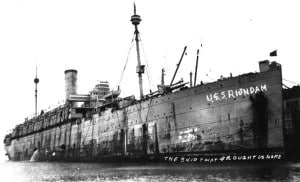 The Rijndam I was used by the USA to transport troops to Europe and after the victory back home again.Here we see the USS Rijndam returning to the States after the war bringing the victorious troops home. This is a scan of a postcard sent home by one of the soldiers. These postcards could be bought in the port from local vendors. Not just from the Rijndam but of other troops ships as well and there are several similar cards in existence that carry the same message, at the same location, as we see written near the waterline at the bow.
The Rijndam I was used by the USA to transport troops to Europe and after the victory back home again.Here we see the USS Rijndam returning to the States after the war bringing the victorious troops home. This is a scan of a postcard sent home by one of the soldiers. These postcards could be bought in the port from local vendors. Not just from the Rijndam but of other troops ships as well and there are several similar cards in existence that carry the same message, at the same location, as we see written near the waterline at the bow.
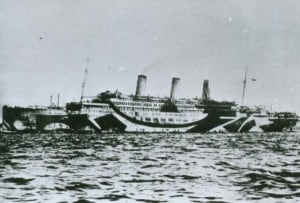 The largest ship that HAL lost in the First World War. Statendam II.
The largest ship that HAL lost in the First World War. Statendam II.
This ship had been ordered just before the war and would be the biggest ship in the HAL fleet upon delivery; with an estimated size of 32.000 tons and a length of 775 feet. However, the war intervened and the ship was converted into a troopship by the British Government. It was renamed in Justicia. In 1918 the ship was torpedoed by a German submarine. Fortunately there were no troops on board so the loss of life was kept to a minimum. As you can see the ship sported a un-usual pattern, painted on the hull. This was called dazzle paint. The hull was painted with a-symmetric lines and patches in Green, white, brown and yellow. The idea was that an U-boat commander, while looking through a periscope, would be confused by this pattern so he could not discern where the ship ended and the sea started. With other words the idea was to dazzle the U-boat commander. However this theory did not work in the case of the Justicia. If you would like to see the wreck of the ship; please use this U-tube link:
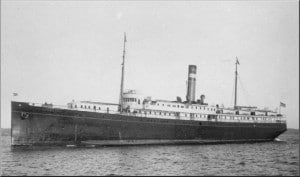 The little steamship Warzawa had been bought from the American Dominion Line and was ater sold back to them.
The little steamship Warzawa had been bought from the American Dominion Line and was ater sold back to them.
After the First World War, all the shipping company’s expected to return to trading in the same way as before the war. A trade that was mainly profitable because of the numbers of emigrants transported to the new world. To improve this service, Holland America bought an old American ship from the Dominion Line called the Madison and renamed it in Warszawa after the capital of Poland. The idea being again that the emigrant could more easily relate to such a name than to a Dutch one. The ship was meant to provide a shuttle service from the Baltic to Rotterdam, carrying 130 in First and 583 in Third class accommodation.
However the emigrant business was dealt a severe blow in 1921, when American Congress imposed the Dillinger Quota act. This act severely restricted the amount of emigrants that a carrier could bring into the USA on a yearly basis. The USA was still struggling to get all the G.I’s to work that had come back at the end of the war and so Congress decided that there was no room for the endless stream of emigrants coming out of Europe.
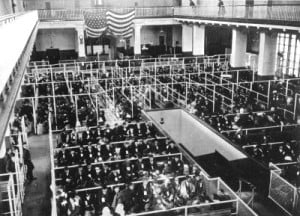 Ellis Island, seen here on a busy day, would see less and less emigrants coming through due to the Dillinger quota act.
Ellis Island, seen here on a busy day, would see less and less emigrants coming through due to the Dillinger quota act.
The restrictions on emigration to the US meant for the shipping companies that they had to re-think their way of trading. Changing the layout of the vessels and replace their lost source of emigrant revenue with something else. Holland America met this challenge in several ways.
Firstly it introduced new routes. Having been traditionally focused on the North Atlantic, it now also opened routes to the Caribbean basin. For this purpose it ordered a quartet of identical passenger cargo liners.
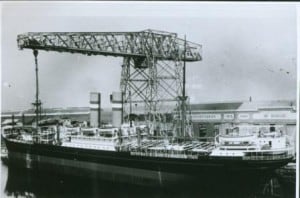 The Edam of 1921 at the builders yard just before delivery to her owners.
The Edam of 1921 at the builders yard just before delivery to her owners.
The company had several ships before that were called Edam but later on in history the name was not used anymore as it was too much associated with the famous cheese of that name. (Same seemed to go for Leerdam, also a name of a cheese and also never used again in the company history)
These four ships were then employed on the Europe to Cuba and Middle America run. They carried 14 First class, 174 second and 802 in third class. That third class was mainly used to take summer laborers to and from the Caribbean. Volume was 8800 tons. It gave a space ratio of 8.9
Secondly it reconfigured the other ships by putting the emphasis on a middle class accommodation called the Tourist class, which was 3rd class with a few bells and whistles. However the different name to the class made it acceptable for people to travel cheaply and not feeling bad about it. Holland America cashed in nicely with the trend of former GI’s going back to Europe with their families to see the First World War battlefields; the places where daddy had fought. By the late twenties it also started to promote student cruises to Europe for which it had founded a special organization called the STCA (Student Third Class Association, later the word third was subsituted by the word tourist) Every year a handbook was issued with notes and (cheap) hotels for the students when traveling through Europe. This organization was the result of the highly successful first Student world cruise, which the Ryndam (I) made in 1927.
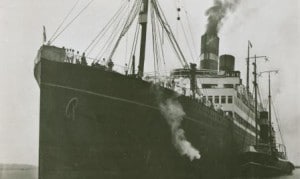 The ss Volendam of 1922; seen here departing from Rotterdam.
The ss Volendam of 1922; seen here departing from Rotterdam.
When the Dillinger Quota Act came into force, the company had two new ships on the stocks. Two intermediate liners, the Veendam and her sister the Volendam. These two ships were designed to be slower then the express liners, the Nieuw Amsterdam and Rotterdam and were to cater for the middle class traveller. The ships had a size of 15,450 tons and an accommodation for 263 First class, 435 second and 1200 third when under construction. This gave them a space ratio of 8.1 When delivered the layout had been adapted to the new circumstances and listed now: 296 First, 396 Second and 292 Third class and that resulted in a space ratio of 15.7
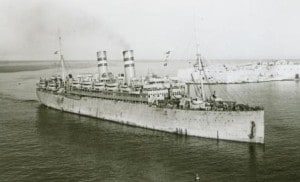 The Volendam sailing as a troopship.
The Volendam sailing as a troopship.
The Volendam worked throughout the war as a troopship and came safely home again when the war was over. However the war had taken such a toll on the ship that shortly after the war she was scrapped.
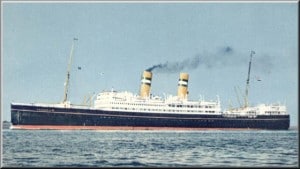 Here we see the Veendam (II) during a postwar sailing.
Here we see the Veendam (II) during a postwar sailing.
Her sister, the Veendam, was docked in Holland at the outbreak of the war and fell in German hands. Spending the war years in Germany as an accommodation ship for submarine crews on leave in Hamburg. Bombed severely near the end of the war, she was recovered by the company partially sunk and burnt out. But as there was a high demand for passages to the USA right after the war, the ship was restored to operational status and put back in service with 195 first and 357 Tourist class. The lower numbers improved her space ratio to 15.8 Her purpose was to mainly carry postwar emigrants on the North Atlantic service and occasionally troops. She was scrapped in 1953 Baltimore, becoming obsolete with the arrival of the new Ryndam and Maasdam and also the Groote Beer for the emigrant trade.
A note in regards to the spelling of the names of the ships; in 1923 Holland America went from Dutch spelling to English spelling and so the ij became the y. Hence the Rijndam of 1900 was spelled Ryndam after 1923. The Ryndam of 1951 started her life with the Y. Although you will find publications once in a while where this is still muddled up.
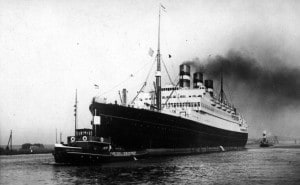 The Statendam III of 1921-29. Many of the interiors fabricated for the Statendam II were utlized for this ship.
The Statendam III of 1921-29. Many of the interiors fabricated for the Statendam II were utlized for this ship.
The sinking of the Justicia or planned Statendam II, made it necessary for the company to design a replacement. As this happened at the same time as the introduction of the US Quota Act, the ship was delayed considerably. Ordered in 1920 it only came into service in 1929. Had the design originally called for 2400 emigrants to be carried; this was now reduced to 995 passengers in Tourist class. It carried a regular complement of First and Second class. With a volume of 29000 tons it had a Space Ratio of 14.3.
With this ship the company had a luxurious answer to face up to the competition and the ship quickly gained the nickname, “Queen of the Spotless Fleet”, Holland America being famous for its Dutch cleanliness on board. However the ship entered service at the time that that Wall Street crashed, so the times in which she was supposed to make a profit, were challenging. With North Atlantic crossings in the summer and extensive cruising in the winter she was however able to earn her keep. She came to an untimely end in 1940, when caught in the cross fire of the German invasion, the ship, while docked in Rotterdam burnt out and the leftovers were scrapped.
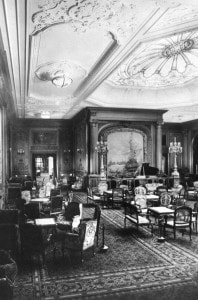 Here the the First class Main lounge. Reaching two decks high. The ship was fitted out by Dutch interior designers and craftsmen; a sign that Dutch shipbuilding now had fully caught up with the times. This lounge had the feature that in the evenings, the carpet could be rolled away and then a wooden dance floor would be available for dancing with the ship’s orchestra providing the music.
Here the the First class Main lounge. Reaching two decks high. The ship was fitted out by Dutch interior designers and craftsmen; a sign that Dutch shipbuilding now had fully caught up with the times. This lounge had the feature that in the evenings, the carpet could be rolled away and then a wooden dance floor would be available for dancing with the ship’s orchestra providing the music.
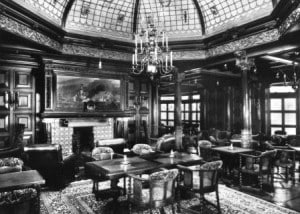 Here we see the First class smoking room, with its glass dome that led natural light into the lounge. Due to the use of interior material of the prewar Statendam II, this room does look a bit old fashioned.
Here we see the First class smoking room, with its glass dome that led natural light into the lounge. Due to the use of interior material of the prewar Statendam II, this room does look a bit old fashioned.
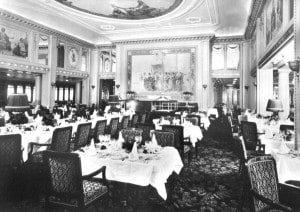
Above the First class restaurant; where the swivel chairs have now given way to regular chairs. Although the ships were still without stabilizers, the idea of swivel chairs and long tables was found to be old fashioned and solace was sought in making the chairs of such a heavy quality that they would hardly move. On some ships the chairs could also be secured to the deck with turnbuckles during very bad weather but I have not been able to find proof that this could also be done on the Statendam III.
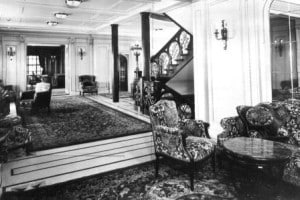
This photo shows the first class staircase on the Promenade deck. In the same way that the atriums on the modern ships are an incorporated into the ships public rooms; it was done here with the first class staircase in a similar way. The staircase has almost become an public room with places to sit and forming a connecting room between the Main lounge and the Library.
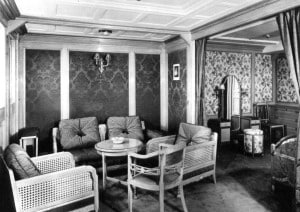
First class passengers lived in opulence and here we see a first class suite with a separate sitting and bedroom area. Attached to it was a luxurious bathroom.
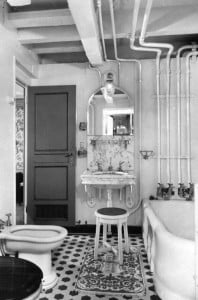 Note the four taps at the head of the bathtub. Two were for hot and cold seawater and two were for hot and cold fresh water. The idea was that you first took your bath in salt water, for which the company supplied special soap and then rinse yourself off with fresh water. Ships in those days could not produce sufficient fresh water and so it had to be conserved were possible. The bather who did not follow the stipulated sequence would find out to his or her embarrassment that Fresh water came only once per bath out of the tap and he/she would be stuck with ending up with salt water at the end of the cycle.
Note the four taps at the head of the bathtub. Two were for hot and cold seawater and two were for hot and cold fresh water. The idea was that you first took your bath in salt water, for which the company supplied special soap and then rinse yourself off with fresh water. Ships in those days could not produce sufficient fresh water and so it had to be conserved were possible. The bather who did not follow the stipulated sequence would find out to his or her embarrassment that Fresh water came only once per bath out of the tap and he/she would be stuck with ending up with salt water at the end of the cycle.
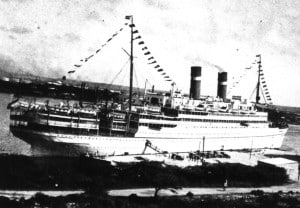 The Rotterdam IV during her West Indies Cruise.
The Rotterdam IV during her West Indies Cruise.
The depression of the 1930’s hit all shipping companies hard. However Holland America was more exposed to it than some of its competitors as it relied mainly on international trade with various partners outside the Netherlands. With trade dwindling, National governments started to favor their own national ships with the reduced trade available and the Holland America Line who could not live off the home market alone was very adversively affected by this. Some cargo ships had to be laid up and the passenger ships were sent cruising as those who were rich enough to afford the tickets were not that affected by the depression. Here we see the Rotterdam IV of 1908 docked in the West Indies during one of her cruises from New York. The company had decided to paint the ship white to give it a more –cruise like- look but with the heavy smoke coming from the funnel this experiment was short lived.
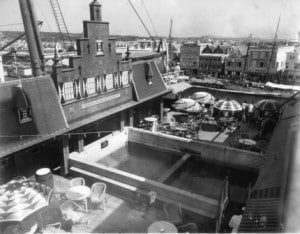 With cruises came the deck parties and the photo shows here that the ships crew built a deck scene resembling a terrace of a Café in Amsterdam. Looking at the houses in the background the port visited was Willemstad in Curacao.
With cruises came the deck parties and the photo shows here that the ships crew built a deck scene resembling a terrace of a Café in Amsterdam. Looking at the houses in the background the port visited was Willemstad in Curacao.
By the mid 30’s the depression started to wane and the company could think about expanding and improving the product again. The Statendam of 1929 badly needed a running mate but the company did not make sufficient money to finance such a project on it’s own. Finally the Dutch government who had always been very leery of subsidizing private enterprises, decided to help as it saw this as an opportunity to get the Dutch Shipbuilding Industry on its feet again.
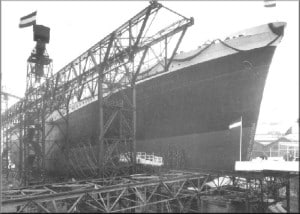 The Nieuw Amsterdam II on the slipway.
The Nieuw Amsterdam II on the slipway.
After two years of protracted negotiations with the Dutch government, HAL received funding to build the Nieuw Amsterdam (II). Building commenced in 1936 and the hull was launched on 10 April 1937. A loan for a sistership was not approved.
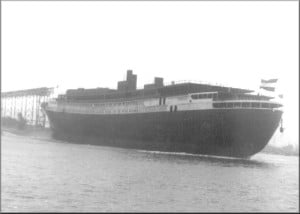
Launched by Queen Wilhelmina of the Netherlands it was by far the biggest ship ever constructed until that time in the Netherlands. As in those days the ships were built entirely by hand, plate by plate, rivet-by-rivet, it would take another full year before the ship would be ready for service. It’s maiden voyage commenced on 10 May 1938. It had a length of 758 feet and a volume of 36000 tons. The ship could carry 556 Cabin class passengers, 455 Tourist class and 209 in 3rd class. space ratio was 29.5 with first class topping the 40 and 3rd class in the region of 15.
Here a U tube link with some footage including the launching. http://www.youtube.com/watch?v=zVlpAh1szo4&feature=related
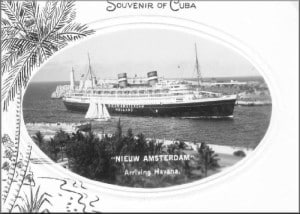
The Nieuw Amsterdam was barely in service when the dark clouds of war started to gather on the horizon. In 1939 Nazi-Germany invaded Poland and Great Britain with France declared war. The Netherlands whose interests were in trading and not in imperialism tried to maintain neutrality, following the same policy as during the First World War. A direct result of the looming war was that the Nieuw Amsterdam was taken of the North Atlantic and sent cruising. Here we see the ship entering the beautiful harbor of Havana. Unfortunately it is a port that we can currently not call at due to the present political situation. During her cruises she sailed fully booked and her guests were very taken with the interiors.
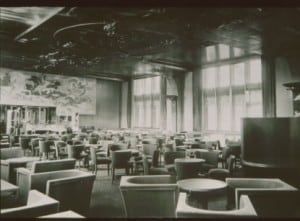 First class Grand Hall. In a form derived from Art Deco. The ceiling had a bass relief that is now hanging in the entrance Hall of the Maritime Museum in Rotterdam.
First class Grand Hall. In a form derived from Art Deco. The ceiling had a bass relief that is now hanging in the entrance Hall of the Maritime Museum in Rotterdam.
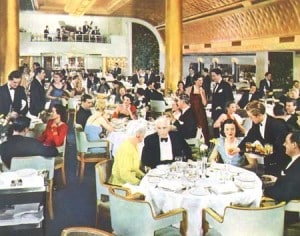 First class Dining room. Please note the orchestra balcony at the upper aft part. An idea that resurfaced in the dining rooms of our S class ships, where there is a similar Orchestra booth located on the upper level.
First class Dining room. Please note the orchestra balcony at the upper aft part. An idea that resurfaced in the dining rooms of our S class ships, where there is a similar Orchestra booth located on the upper level.
As Germany once again attacked the worlds shipping by means of U-boats; Neutral lettering and the country flag had to be displayed on the sides of the hull. Then the hope was that a U-boat commander would read before he would shoot. Here we see the Binnendyk, a B-class cargo liner from the 1920.s The B-class consisted out of a series of 8 ships, whose names all started with a B and who had been built with steel given by Great Britain to compensate for the loss of the Justicia (Statendam II).
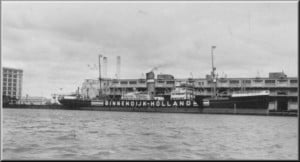 The Cargoship Binnendyk of 1921.
The Cargoship Binnendyk of 1921.
The neutral letting on the hull might have helped against U-boats, it however not help against mines. The Binnendyk was the first HAL ship to be lost in the war when it hit a mine on 7 October 1939. This was even before the war came to the Netherlands.
PLEASE CONTINUE TO PART 3.

April 1, 2009 at 6:56 am
Excellent Job!
Could you send me in the right direction.
I am trying to find a passenger list from the Volendam sailing from Hoboken, NJ to Rotterdam on approx. July 16, 1927
Much appreciated.
frank Wellink
February 16, 2014 at 9:29 am
I sailed with my parents on the old Volendam in June of 1940 from the UK to NYC for 15 days under naval escort. I will be sailing on the new Volendam next month from Singapore to Japan 74 years later. Is it still possible to obtain the passenger list from that 1940 sailing?
May 7, 2014 at 5:23 pm
My father returned to Canada on the Volendam at the end of the war. He had been injured in Belgium and sent to recoup on Nancy Astor’s estate prior to being shipped back to Canada. What a beautiful ship. I’m so glad he remembered this part of history and that you’ve posted photos of the ship so we, too, can see how he made his way back from WWII. Thank you!!
November 12, 2015 at 4:55 pm
I am trying to find out the dates that the Volendam II landed in Quebec City in 1951. I need it for my application for my Old Age Pension. I know that last landing was in October 1951 but apparently we arrived on the third last sailing of the ship to Canada. It was sold for scrap in 1952. Any help would be much appreciated.
November 12, 2015 at 5:47 pm
Thank you for reading my blog,
I will be glad to help you with your pension:
The Volendam called at Quebec in 1951 during 5 voyages, see below. It did not call at Quebec during voyage 232.
But if you remember the month in which you arrived, then the figures below should help.
First number is the voyage, then departure and return date to Rotterdam and then the ports it called at.
227 14 apr – 06 may Rdam – Que (24 – 26) – Rdam —————————> In Quebec from 24 to 26 April
228 15 may – 08 jun Rdam – Que (25 – 27) – Montreal – Leh – Rdam ———-> In Quebec from 25 to 27 May
229 13 jun – 07 jul Rdam – Leh – Que (23 – 25) – Montreal – Rdam…………> In Quebec from 23 to 25 June
230 11 jul – 02 aug Rdam – Leh – Que (21 – 22) – Montreal – Leh – Rdam…> In Quebec from 21 to 22 July
231 07 aug – 30 aug Rdam – Leh – Quebec (17 – 19) – Montreal – Rdam………> In Quebec from 17 to 19 Aug
233 02 oct – 22 oct Rdam – Que (11 – 13) – Rdam………………………..> In Quebec from 11 – 13 Oct
The ship normally arrived in the late afternoon, exact time depending on the current up the St. Lawrence so it is
hard to say on which date you would have disembarked. I believe Pier 21 (Canada’s official Immigration Museum)
in Halifax also has some landing details of those who landed in Quebec or Montreal, so if you need manifest proof,
it might be worthwhile calling them. Details are on their website.
Happy Retirement
Capt. Albert.
March 9, 2022 at 12:51 pm
I believe my father escaped Holland on May 15 , 1940 on board this ship as a member of the crew and came to New York illegally as a Dutch Jew.He said he escaped ” On the last boat out” How would I find any records?
March 11, 2022 at 9:56 am
Good morning
thank you for your comment. This is a little bit vague as you did not mention a first and last name. And I can only help with the HAL side. The last HAL ship to leave Holland was the ss Delftdijk which left Holland on 5 May. It sailed via Antwerp to NY. On arrival your father wold have been processed by the immigration authorities and thus he should be in the records. Please try the below link to find him.
https://heritage.statueofliberty.org/passenger
Please note that the authorities sometimes garbled the names, so an an example if the last name was Jansen, and nothing shows up, you might also try the version janssen, janzen etc.
If I can do anything else, please let me know
Best regards
Albert
May 14, 2019 at 1:25 am
Good day
My family sailed on this ship also.I believe we arrived in 1951 landing in Halifax.I was 2 years old along with my sister 4 years and my parents which are now both deceased.
John Waning
April 12, 2016 at 6:43 pm
Many thanks for taking the time to reply. This information has proven to be really helpful.